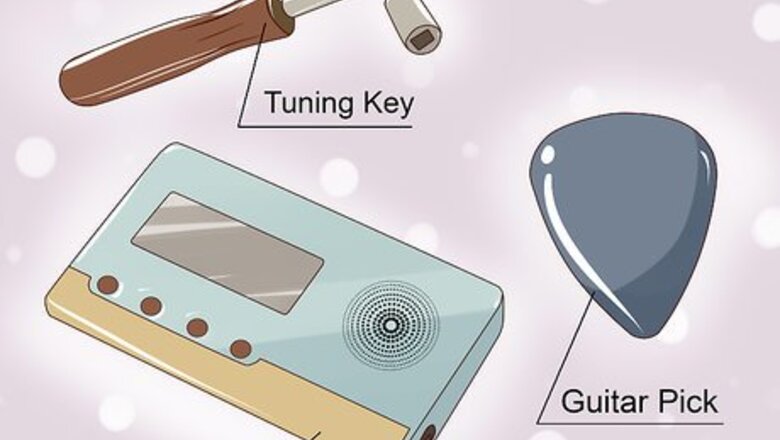
views
- To tune your lap harp, first pluck the lowest string and check it against a tuner or a reference note from a piano.
- Use your harp’s tuning key to slowly twist the string’s tension knob and adjust the pitch. Tighten the string to raise the pitch, or loosen it to lower the pitch.
- Repeat for all 15 strings in ascending order. On a standard G-major lap harp, the pitches should be: G, A, B, C, D, E, F#, G, A, B, C, D, E, F#, G.
Tuning Your Lap Harp to a Diatonic Major Scale
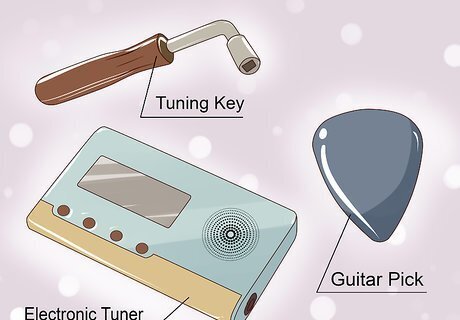
Purchase a tuning key, electronic tuner or tuner app, and guitar pick. Most lap harp kits and electronic tuners include a tuning key—a small L-shaped silver instrument with a square hole that fits over the tuning pegs on the sides of the instrument. After fitting the key onto a tuning peg, turning the handle changes the key of each string. Tuners either clip to the body of the harp or are placed close to the harp to pick up its sound. If you don’t have a physical tuner, there are many free tuning apps you can download, like Perfect Tuner or FIne Tuner. Set your tuner to A=440 Hz if it's not already (most are set to this frequency by default). This is standard tuning and allows you to play in tune with other instruments. A guitar pick is also recommended to strum individual strings clearly and easily. If you don’t have a pick, try making one from cardboard or just using your fingers.
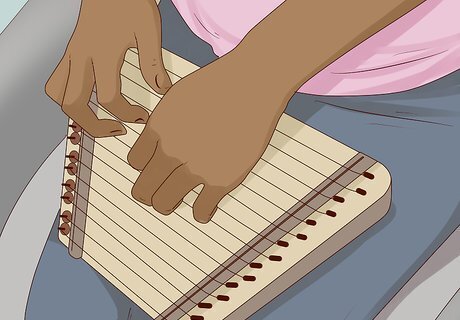
Place the harp on your lap or a flat surface with your tuner nearby. Position the lap harp with the narrow, pointed end facing forward. There will be 15 immovable (and possibly colored) pegs on the left that anchor the strings, and 15 twistable, square-ish pegs on the right that control the tension of the string (and therefore, the pitch). Sit in a position that is comfortable enough to maintain for a good 15 to 20 minutes. Clip your electronic tuner onto the harp's wooden body near the strings you want to tune or, if it doesn't have a clip, set it very close to the harp so it still picks up the sound. Move the tuner as you go so it’s always close to the string you’re adjusting. If you don’t have a tuner or tuner app, position yourself near a keyboard or in-tune piano. Play the notes you’re tuning on the piano for a reference pitch.
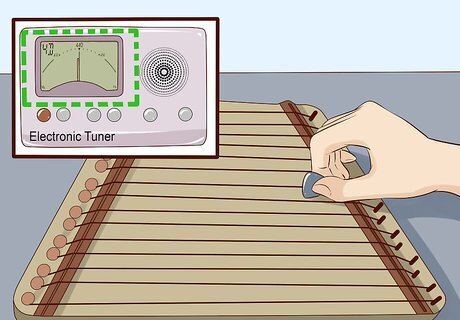
Strum the lowest string first and check the pitch on your tuner. The tuner will tell you whether the pitch is too low (flat) or too high (sharp), typically by displaying a needle moving to the left or right of a note name (like G, A, C, etc.). Many lap harps are pitched in G major, meaning the lowest string sounds the note G. For a standard 15-string G-major lap harp, the strings sound the following pitches (from lowest to highest): G, A, B, C, D, E, F# (F-sharp), G, A, B, C, D, E, F#, G. Some lap harps may be pitched in different keys, meaning the strings are tuned to different pitches. Check your lap harp’s tuning kit (if you have it) or look at a product description online if you’re not sure which key your instrument is in. Many lap harps come with a sheet with all the notes marked, as well as tuning instructions. Be sure to have this (or write down the notes above on a paper) as a reference for which notes each string needs to be tuned to.
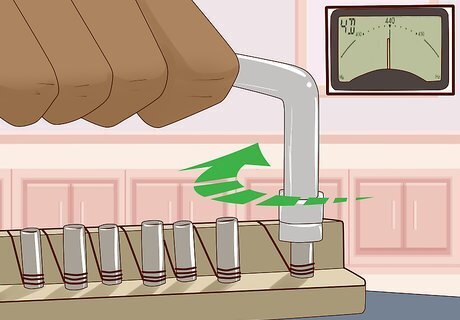
Tighten the string by slowly turning the tuning key clockwise if it’s flat. If the tuner indicates the pitch is low (or it sounds low compared to the same note on the piano), tightening the string will raise the tension and the pitch. Hook the tuning key onto the string’s tuning knob, strum the note clearly until it shows up on the tuner, and then slowly tighten the string. As the note is fading away, you'll hear the pitch begin to change as you tighten. Use this as a guide as to how much you've changed the sound, and if you're going higher or lower. Stop tightening the string when the tuning needle centers. Be extra careful not to tighten the string too quickly or with lots of force. The strings are thin and could snap if the tension is too high. Make sure the tuner is displaying the correct note name (in this case, G). If the string is severely out of tune, the tuner may think you’re tuning a different pitch like G♭ (G-flat), G# (G-sharp), or even a whole other note name.

Loosen the string by turning the tuning key counterclockwise if it’s sharp. If the pitch is too high, hook the tuning key onto the string's peg, strum the note clearly, and gently turn it counterclockwise. Stop loosening the string once the tuner reads G. Watch the screen carefully and stop turning the key once the tuner displays the correct note and the needle is centered. Note that some harps may be stringed differently, meaning a counterclockwise turn might raise the pitch instead of lowering it. Test your harp to make sure you know which way to go.
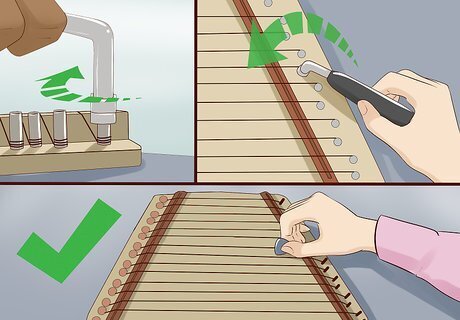
Continue this process with all the strings until they're tuned. Tuning can be slow and tedious work, so take plenty of breaks. If you come across a particularly difficult string, come back to it later. Check your progress periodically by playing up and down through the strings you've tuned. Make any adjustments as you go along. Even experienced lap harp players may need to tune all their strings 2 or 3 times to get them exactly right. For a quick pitch check, play your strings in octaves (for example, playing a low G and high G at the same time). You’ll easily hear whether the notes “lock in” (are in tune) or clash (are out of tune).
Other Tuning Systems
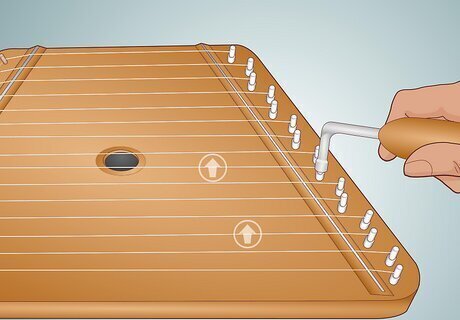
Raise the 3rd and 7th notes of the scale by a half step for a glissando effect. In harp playing, a glissando is when you strum a large range of strings up or down in one motion. While you can do this without altering the tuning, the half step intervals between the 3rd and 4th notes of a scale and the 7th and 8th notes can sound dissonant. So, tighten the strings corresponding to the 3rd and 7th notes of the scale until they match the strings right above them. On a G-major lap harp, this means tightening your B strings (the 3rd note of the G major scale) up to C and your F# strings (the 7th note of the scale) up to G. From lowest to highest, the strings would sound: G, A, C, C, D, E, G, G, A, C, C, D, E, G, G.
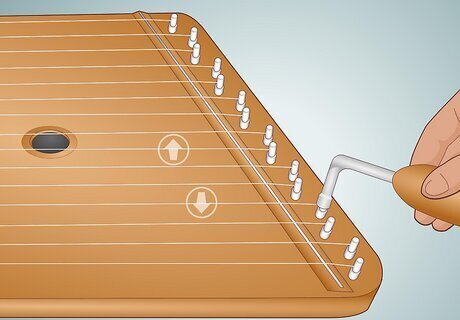
Lower the 4th note of the scale and raise the 7th note for a pentatonic scale. A pentatonic scale is a scale that uses 5 notes instead of 7. It’s great for improvising since none of the notes will clash or sound too dissonant when played together or in a row. To get this sound, loosen the strings corresponding to the 4th note of the scale so the pitch goes down a half step (matching the string below). Then, raise the 7th note strings up a half step (matching the strings above). On a G-major lap harp, the notes from lowest to highest become: G, A, B ,B, D, E, G, G, A, B, B, D, E, G, G.

Lower the 3rd, 6th, and 7th notes of the scale to tune a minor scale. While major scales sound bright and cheerful, minor scales are darker and more melancholy sounding. If you want this sound, loosen the strings corresponding to the 3rd, 6th, and 7th notes of the scale by a half step. Unlike the options above, you’ll still have 7 distinct notes with no strings doubling each other. On a G-major lap harp, the minor scales notes from lowest to highest would be: G, A, B♭, C, D, E♭, F, G, A, B♭, C, D, E♭, F, G.















Comments
0 comment